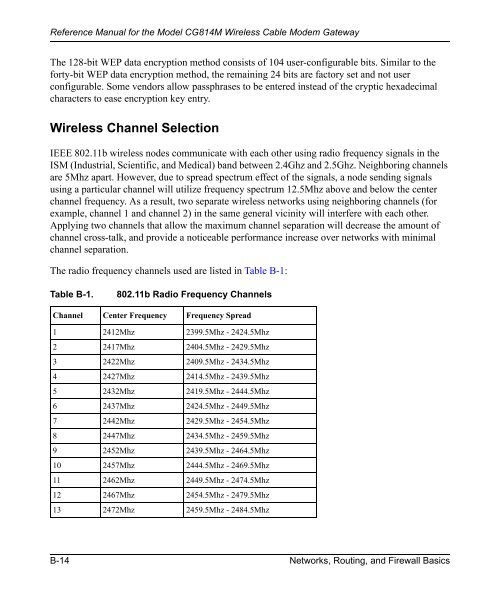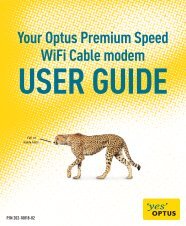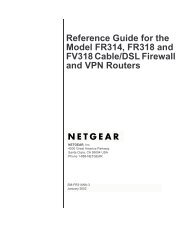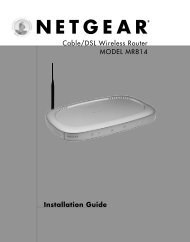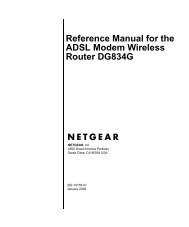Reference Manual for the Model CG814M Wireless Cable ... - netgear
Reference Manual for the Model CG814M Wireless Cable ... - netgear
Reference Manual for the Model CG814M Wireless Cable ... - netgear
You also want an ePaper? Increase the reach of your titles
YUMPU automatically turns print PDFs into web optimized ePapers that Google loves.
<strong>Reference</strong> <strong>Manual</strong> <strong>for</strong> <strong>the</strong> <strong>Model</strong> <strong>CG814M</strong> <strong>Wireless</strong> <strong>Cable</strong> Modem Gateway<br />
The 128-bit WEP data encryption method consists of 104 user-configurable bits. Similar to <strong>the</strong><br />
<strong>for</strong>ty-bit WEP data encryption method, <strong>the</strong> remaining 24 bits are factory set and not user<br />
configurable. Some vendors allow passphrases to be entered instead of <strong>the</strong> cryptic hexadecimal<br />
characters to ease encryption key entry.<br />
<strong>Wireless</strong> Channel Selection<br />
IEEE 802.11b wireless nodes communicate with each o<strong>the</strong>r using radio frequency signals in <strong>the</strong><br />
ISM (Industrial, Scientific, and Medical) band between 2.4Ghz and 2.5Ghz. Neighboring channels<br />
are 5Mhz apart. However, due to spread spectrum effect of <strong>the</strong> signals, a node sending signals<br />
using a particular channel will utilize frequency spectrum 12.5Mhz above and below <strong>the</strong> center<br />
channel frequency. As a result, two separate wireless networks using neighboring channels (<strong>for</strong><br />
example, channel 1 and channel 2) in <strong>the</strong> same general vicinity will interfere with each o<strong>the</strong>r.<br />
Applying two channels that allow <strong>the</strong> maximum channel separation will decrease <strong>the</strong> amount of<br />
channel cross-talk, and provide a noticeable per<strong>for</strong>mance increase over networks with minimal<br />
channel separation.<br />
The radio frequency channels used are listed in Table B-1:<br />
Table B-1. 802.11b Radio Frequency Channels<br />
Channel Center Frequency Frequency Spread<br />
1 2412Mhz 2399.5Mhz - 2424.5Mhz<br />
2 2417Mhz 2404.5Mhz - 2429.5Mhz<br />
3 2422Mhz 2409.5Mhz - 2434.5Mhz<br />
4 2427Mhz 2414.5Mhz - 2439.5Mhz<br />
5 2432Mhz 2419.5Mhz - 2444.5Mhz<br />
6 2437Mhz 2424.5Mhz - 2449.5Mhz<br />
7 2442Mhz 2429.5Mhz - 2454.5Mhz<br />
8 2447Mhz 2434.5Mhz - 2459.5Mhz<br />
9 2452Mhz 2439.5Mhz - 2464.5Mhz<br />
10 2457Mhz 2444.5Mhz - 2469.5Mhz<br />
11 2462Mhz 2449.5Mhz - 2474.5Mhz<br />
12 2467Mhz 2454.5Mhz - 2479.5Mhz<br />
13 2472Mhz 2459.5Mhz - 2484.5Mhz<br />
B-14 Networks, Routing, and Firewall Basics


